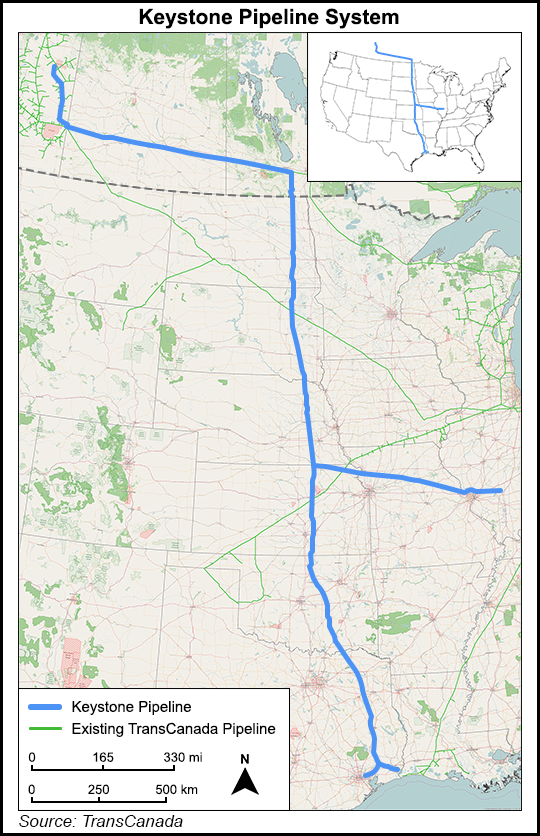Shale Daily | Bakken Shale | E&P | Infrastructure | NGI All News Access
TransCanada Shuts Keystone Pipe in South Dakota Following Leak
TransCanada Corp.’s Keystone pipeline system sprang a leak Thursday, only days before a scheduled regulatory ruling on the hotly contested XL proposal for a jumbo addition.

A leak on private farmland occurred on a 35-mile segment south of the Ludden pump station near Amherst, SD, in Marshall County. Initial reports indicated about 210,000 gallons, around 5,000 bbl of crude oil, leaked from the 590,000 b/d system.
TransCanada coordinated an initial response to the incident within 15 minutes of a pressure drop being noted around 6 a.m. Thursday, the company said. The pipeline operator said it cooperating with authorities, including the U.S. Pipeline and Hazardous Materials Safety Administration, which regulates interstate oil pipelines.
State officials told NGI‘s Shale Daily late Thursday that there appeared to be no impact on groundwater supplies and no immediate public health concerns. The extent of the contamination to the soil in the area and the cause of the leak were still to be determined, according to an official with the South Dakota Department of the Environment and Natural Resources (DENR).
TransCanada has informed shippers and customers that the pipeline that moves oil from Hardisty, AB to the oil hub in Cushing, IL, and the hub at Wood River/Patoka, IL, is expected to remain shut down while the spill is assessed.
The Marketlink pipeline system, which uses the facilities of the southern leg of the Keystone pipeline system from Cushing to the Gulf Coast, is not affected.
“Crews, including TransCanada specialists, as well as nationally recognized experts, are assessing the situation,” a TransCanada spokesperson said.
The oil spill occurred in a grassy area on rural, private land in which the nearest farm is about a mile away.
“It is a fairly isolated area, and as far as the overall impact area’s size, I don’t know that,” a DENR official said. “What we do know is that there is visible oil on the surface, but it is not a large area. We still don’t know how big of an area underground is affected, however.”
Beginning Friday, response crews were expected to determine how large an area has been impacted.
“It will probably be Friday or Saturday when they start doing some excavation work,” said the DENR official.
TransCanada’s Keystone system from the Western Canadian Sedimentary Basin has been in place since 2010.
The mishap struck one day after the Nebraska Public Service Commission (PSC) set Monday (Nov. 20) for a long-awaited state ruling on the 890,000 b/d Keystone XL project. The proposed fourth phase, Keystone XL, initially rejected by the Obama administration, was approved by the Trump administration earlier this year.
Pipeline opponents, still fighting Keystone XL in the name of breaking oil habits blamed for climate change and environmental degradation, leaped on the accident as proof that Obama’s rejection was the correct decision.
Greenpeace and the Sierra Club led the attack by urging Nebraska regulators to reject the expansion project. The leak “is making our case for us” that spills are inevitable threats to water supplies and public safety, they said.
“Even if Nebraska’s PSC approves the permit, the fight’s not over yet,” said Rainforest Action Network’s Jason Disterhoft, senior climate and energy campaigner. “For Keystone to get built, it needs two things: permits and money.
“There is no indication that TransCanada will look for a project loan for Keystone, so any bank that’s backing TransCanada is backing Keystone. Banks should drop TransCanada unless they want to get caught up in the controversy around the pipeline.”
In less than a month, TransCanada’s banks “have a major decision to make,” he said. “The company’s $1.5 billion credit facility with 19 banks expires on Dec. 15. JPMorgan Chase, the lead bank on TransCanada’s credit facility, along with 18 other banks, will decide whether or not to renew the credit facility at that time.”
© 2024 Natural Gas Intelligence. All rights reserved.
ISSN © 2577-9877 | ISSN © 2158-8023 |
